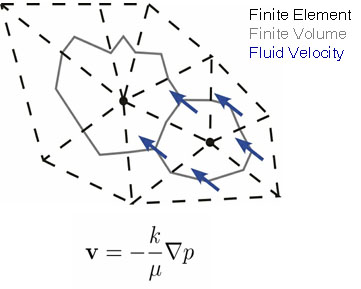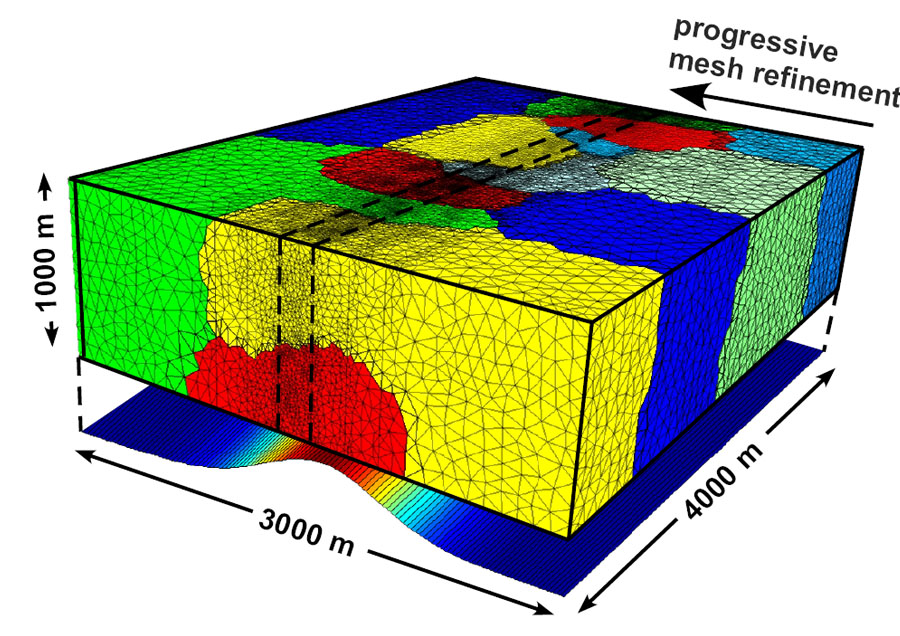Finite Element - Finite Volume Algorithms

Several people in our group have been working on the development of advanced set of simulation tools. This integrated collection of tools is called the CSMP++, and has been written as an object-oriented C++ library with interfaces to many in- and output formats. CSMP++ development has become a major effort of several research groups and we meet anually for a 1 week workshop to exchange ideas.
CSMP++ started as "CSP" in the mid-nineties with Stephan Matthai (now at Imperial College) implementing the large core part of the platform. The core of CSP are combined finite-element and finite-volume algorithms that are responsible for handling the diffusive (FE) and advective (FV) parts of the governing equations. During his PhD studies in our group (finished 2004), Sebastian Geiger (now at Heriot Watt University) developed a combined finite element - finite volume algorithm that can accurately and reliably handle the flow of mixed water-salt fluids including the full complexity of the phase diagram and strongly non-linear P-T-X dependence of fluid properties.
The algorithm decouples the diffusion type and advection type governing equations, solves the former using a semi-implicit finite element approach and uses the respective velocity information to solve the latter via a higher-order, mass conserving finite volume scheme. In order to ensure that the decoupling does produce correct results, Diploma student Adrian Burri from ETH Zurich's computational science programme implemented a fully coupled finite element scheme such that reference solutions for various problems could be computed. Differences between the two solutions are negligible and Geiger's scheme turned out to be computationally much more efficient and stable. In fact, solutions for several flow problems appear to be more accurate than those of the fully coupled scheme.
In order to resolve the full thermodynamic complexity of the phase transitions that occur during flow, the simulation scheme has been modified over the last two years by Thomas Driesner, Dim Coumou and Philipp Weis. The image on the right shows how ell the new scheme compares with established codes. We are now using an enthalpy-pressure-salinity-based approach that has found its first application in the accurate simulation of MOR hydrothermal system.
A major step towards large scale simulations was the parallelization of the code, which follows a domain-decomposition approach and was implemented by Dim Coumou. The figure shows an example how a 3D-model is divided into several domains (color coded), each of which is assigned to a different processor that solves the governing equations for this domain only.
Selected publications
Coumou D, Driesner T, Geiger S, Paluszny A & Heinrich CA (2009a) High-resolution three-dimensional simulations of mid-ocean ridge hydrothermal systems. Journal of Geophysical Research-Solid Earth, 114, DOI 10.1029/2008jb006121.
Coumou D, Driesner T, Weis P & Heinrich CA (2009b) Phase separation, brine formation, and salinity variation at Black Smoker hydrothermal systems. Journal of Geophysical Research-Solid Earth, 114, DOI 10.1029/2008jb005764.
Coumou D, Driesner, T., and Heinrich, C. A. (2008a) Heat transport at boiling, near-critical conditions. Geofluids,208-215.
Coumou D, Driesner, T., and Heinrich, C. A. (2008b) The Structure and Dynamics of Mid-Ocean Ridge Hydrothermal Systems. Science,1825-1828.
Coumou D, Matthäi S.K., Geiger S. and Driesner T. (2008c) A parallel FE–FV scheme to solve fluid flow in complex geologic media. Computers & Geosciences.
Driesner T & Geiger S (2007) Numerical simulation of multiphase fluid flow in hydrothermal systems. In: Fluid-Fluid Interactions – Reviews in Mineralogy and Geochmistry (eds Liebscher A & Heinrich CA), 65, 187-212.
Matthai, S. K., Geiger, S., Roberts, S. G., Paluszny, A., Belayneh, M., Burri, A., Mezentsev, A., Lu, H., Coumou, D., Driesner, T., and Heinrich, C. A. (2007): Numerical simulation of multi-phase fluid flow in structurally complex reservoirs, in Jolley, S. J., Barr, D., Walsh, J. J., and Knipe, R. J., eds., Structurally Complex Reserviors, 292. Geological Society Special Publication: London, The Geological Society, p. 405-429.
Paluszny, A., Matthai, S., Hohmeyer, M., 2007. Hybrid finite element finiite volume discretization of complex geologic structures and a new simulation work flow demonstrated on fractured rocks.
Geofluids 7, 1-23.
Coumou D, Driesner T, Geiger S, Heinrich CA & Matthai S (2006) The dynamics of mid-ocean ridge hydrothermal systems: Splitting plumes and fluctuating vent temperatures. Earth and Planetary Science Letters, 245,218-231.
Geiger S, Driesner T, Heinrich CA & Matthai SK (2006a) Multiphase thermohaline convection in the earth's crust: I. A new finite element - Finite volume solution technique combined with a new equation of state for NaCl-H2O. Transport in Porous Media, 63,399-434.
Geiger S, Driesner T, Heinrich CA & Matthai SL (2006b) Multiphase thermohaline convection in the earth's crust: II. Benchmarking and application of a finite element - Finite volume solution technique with a NaCl-H2O equation of state. Transport in Porous Media, 63,435-461.
Geiger S, Driesner T, Heinrich CA & Matthai SK (2005) On the dynamics of NaCl-H2O fluid convection in the Earth's crust. Journal of Geophysical Research-Solid Earth, 110.
Geiger, S. (2004) Numerical simulation of the hydrodynamics and thermodynamics of NaCl-H2O fluids. Ph.D. thesis, ETH Zurich, Switzerland.
Geiger, S., Roberts, S., Matthai, S., Zoppou, C., Burri, A. (2004) Combining finite element and finite volume methods for efficient multiphase flow simulations in highly heterogeneous and structurally complex geologic media. Geofluids 4, 284-299.
Geiger, S., Driesner, T., Matthäi, S.K., and Heinrich, C. A. (2006a) Multiphase Thermohaline Convection in the Earth's Crust: I. A Novel Finite element - Finite Volume Solution Technique Combined with a New Equation of State for NaCl-H2O. Transport in Porous Media 63(3), 399-434.
Geiger, S., Driesner, T., Matthäi, S.K., and Heinrich, C. A. (2006b) Multiphase Thermohaline Convection in the Earth's Crust: II. Benchmarking and Application of a Finite element - Finite Volume Solution Technique with a NaCl-H2O Equation of State. Transport in Porous Media 63(3), 435-461.
Contact
Inst. für Geochemie und Petrologie
Clausiusstrasse 25
8092
Zürich
Switzerland

